Feeding chickens on a budget is usually a top priority for the small farmer. With feed costs steadily on the rise, it’s harder than ever to keep your flock fed and happy on a budget. However, I’ve got a few tips I’ve learned over the years to keep your flock happy and healthy without spending a fortune.
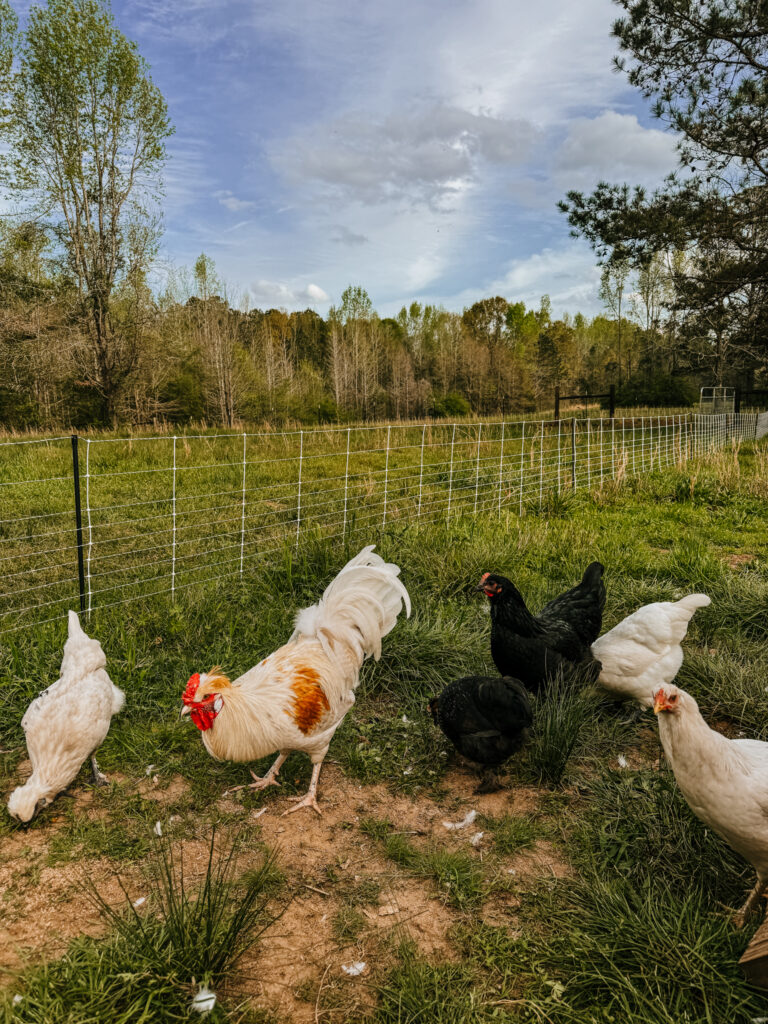
I’m Casey, and I’ve been keeping chickens for years. With a large laying flock of over 100 chickens and 150 or more broilers in chicken tractors, you could say I’ve learned a thing or two. I also have a background as a registered nurse and a high school teacher. This combination gives me an understanding of chicken health and how to research it, ensuring that my flock is happy, healthy, and well-fed without breaking the bank. So, let’s talk chicken feed!
Common Chicken Feed
Let’s talk about the basics. When it comes to feeding your backyard laying flock, you’ve got a few options. Scratch grains, laying pellets, and crumbles are the most common choices you’ll find. Each one has its pros and cons, but don’t worry, I’ll break it down for you.
Scratch grains are like the chicken equivalent of a snack mix – a little bit of everything tossed together. They’re great for giving your hens some variety, but they might not have all the nutrients your girls need to lay those delicious eggs. Scratch grains are usually made up of corn, oats, and other grains.
Laying pellets, on the other hand, are like the chicken version of a balanced meal. They’re specifically formulated to give your hens all the things they need to lay eggs. Plus, they’re super convenient.
And then there are crumbles, which are basically pellets in bite-sized pieces. They’re perfect for young chicks or older hens who might have trouble gobbling up those big pellets. Crumbles are often made up of higher protein content and lower calcium.
There are also other high-protein feeds available for broilers. You wouldn’t normally feed this to your backyard laying flock.
I feed my laying flock a non-GMO feed made by Tucker Milling. I like it because the main ingredients aren’t corn or soy.
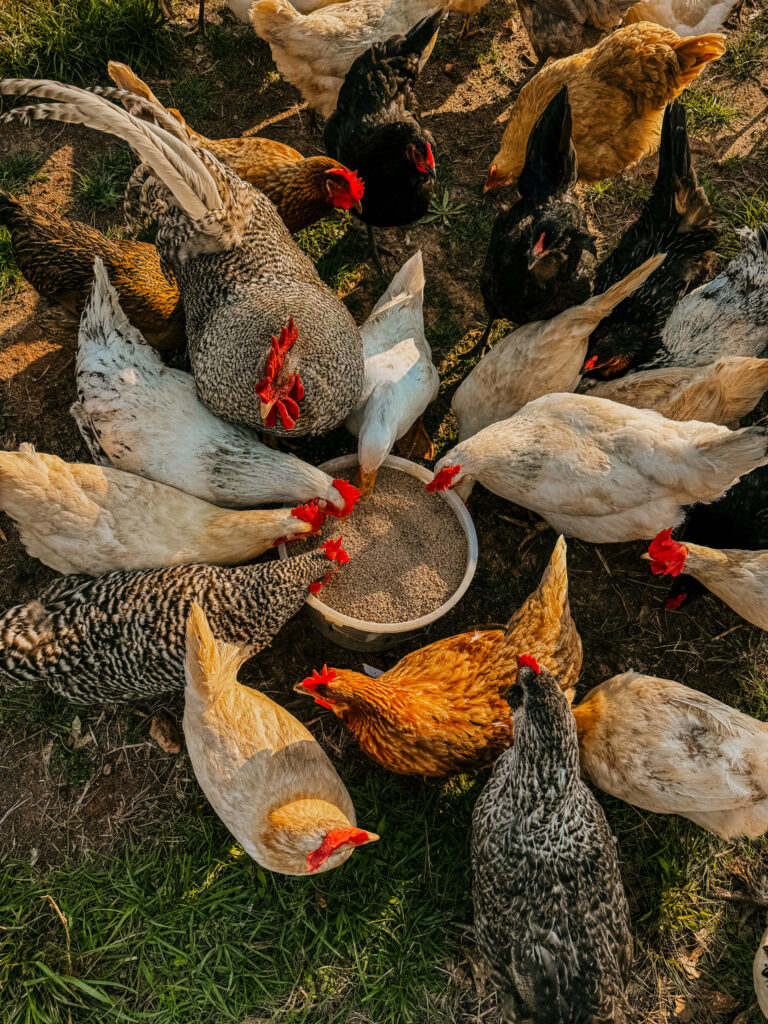
Feeding Chickens on a Budget
***This post may contain affiliate links which means I make a small commission at no extra cost to you. Read my full disclosure here.*
Free-Range Chickens
Now, let’s get to the good stuff. One of the cheapest (and most fun) ways to feed your flock is by letting them free-range. That means letting your chickens roam around your yard, eating bugs, and foraging for tasty treats. Not only is it budget-friendly, but it’s also great for your chickens’ mental and physical health. Chickens have been surviving on their own long before feed sacks were a thing.
If you’re unsure about letting your chickens roam, check out my post on how to free-range chickens. Also, some breeds are more suitable for free-ranging than others. Be sure to read about the best backyard chicken breeds.
Growing a Chicken Garden
Another money-saving strategy is growing a chicken garden. Plant some chicken-friendly veggies like kale, lettuce, and even some herbs like oregano and parsley. Your hens will love pecking and scratching away, and you’ll love saving a few bucks on feed. This also helps to keep them out of your kitchen garden, which I’ve found to be a major benefit.
Feeding Chickens Kitchen Scraps
Don’t toss those kitchen scraps in the trash. Your chickens will gladly eat them. Just make sure to avoid feeding them anything too salty, spicy, or moldy.
While we’re on the topic of no-nos, let’s talk about foods that chickens shouldn’t eat. Stay away from avocado pits, chocolate, and anything caffeinated – they’re toxic to chickens. It’s best to steer clear of raw beans and onions too. They can cause some serious tummy troubles. Stick to chicken-friendly snacks like veggies, fruits, and grains.
Fermenting Grains
Fermenting grains is also a great way to stretch your feed budget. It might sound fancy, but it’s actually super simple. Just soak your grains in water for a day or two in a 5-gallon bucket. Not only does fermenting grains stretch your feed budget further, but it also boosts your chickens’ gut health and nutrient absorption. More on how to ferment chicken food here.
More Budget-Friendly Tips For Feeding Chickens
- Order in Bulk: Buying chicken feed in bulk can save you a lot in the long run. Look for local farmers’ cooperatives or online suppliers that offer bulk discounts. Plus, you’ll save on shipping fees too.
- Direct from the Mill: Cut out the middleman and buy your feed directly from the mill. Not only can you score some good deals, but you’ll also get fresher feed straight from the source. Just make sure to check the quality before you stock up. I’ve bought directly from a local mill in the past and received a great product.
- Rationing Feed: This might sound a bit strict, but rationing your chickens’ feed can actually save you a ton of money. Chickens will eat a lot more if you allow them free choice all day. Aim for around 1/4 to 1/3 pounds of feed per chicken per day. Adjust the amount based on your chickens’ size, breed, and activity level.
- Bulk Up with Grains: Consider supplementing your chickens’ diet with grains like oats, barley, or wheat. They’re cheaper than commercial feed and can provide a boost of energy for your hens.
- Proper Storage: Keep your feed fresh and pest-free by storing it in airtight containers. This helps prevent spoilage and keeps pests like rodents and insects at bay, saving you money in the long run.
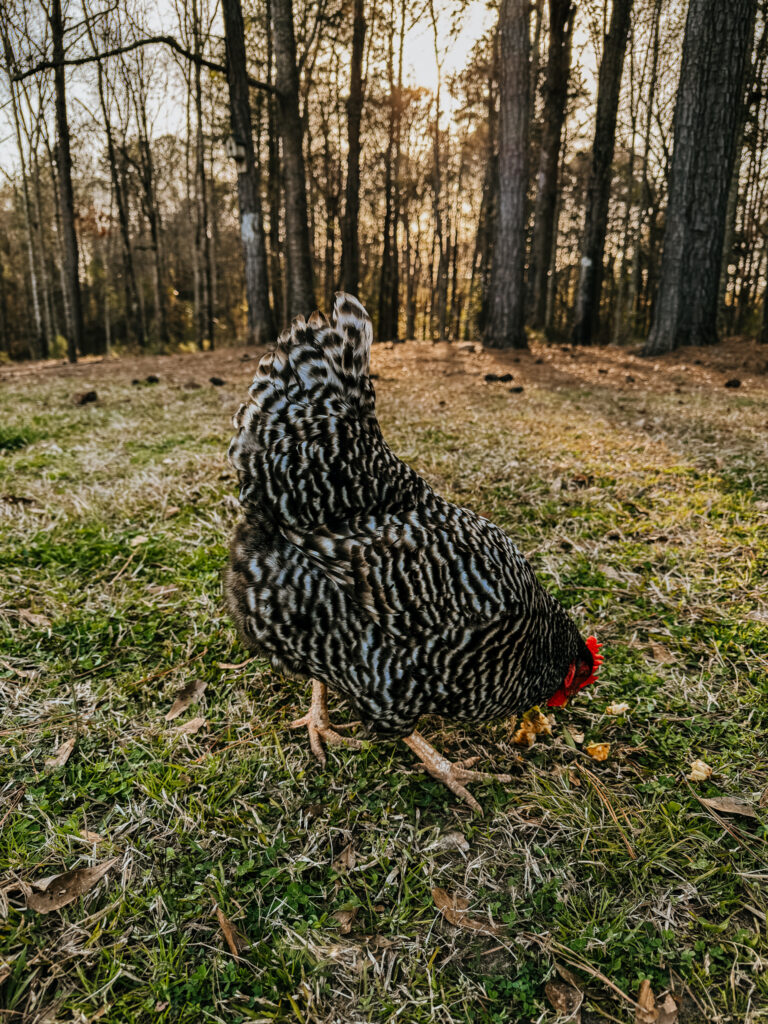
Feeding Chickens Using Chicken Tractors
Chicken tractors are like RV’s for your flock! When your chickens aren’t able to free-range, a chicken tractor can be a game-changer for rotational grazing.
So, what exactly is a chicken tractor? Think of it as a mobile coop that allows your chickens to roam and graze on fresh grass while still keeping them contained and safe from predators.
But why bother with a chicken tractor? Well, let me break it down for you:
Rotational Grazing: One of the biggest benefits of using a chicken tractor is rotational grazing. Instead of letting your chickens free-range in the same area day after day, you can move the tractor to fresh pasture regularly. This not only gives your chickens access to a variety of grasses and bugs but also prevents overgrazing and keeps your lawn or garden healthy.
Natural Pest Control: Chickens are natural-born bug hunters, and a chicken tractor allows them to do what they do best. By moving the tractor around your yard or garden, you can target specific areas where pests are a problem and let your chickens go to town.
Free Fertilizer: As your chickens graze, they also leave behind a little fertilizer. Their droppings enrich the soil with nitrogen, phosphorus, and potassium, helping to promote healthy growth. Plus, by moving the tractor regularly, you can distribute the fertilizer evenly across your lawn or garden.
Weed Control: Chickens aren’t picky eaters – they’ll happily gobble up weeds along with grass and bugs. By rotating your chicken tractor through areas with weeds, you can help keep them in check naturally, reducing the need for chemical herbicides.
Protection from Predators: While free-ranging chickens are vulnerable to predators like foxes, raccoons, and hawks, a chicken tractor provides a safe and secure environment for your flock. The enclosed coop keeps predators out while still allowing your chickens to enjoy the great outdoors.
Pasture Grazing
When it comes to setting up a pasture for a budget-friendly chicken feed, choosing the right plants can make all the difference. Here are some chicken-friendly options to consider planting:
Grasses
Planting a variety of grasses like Bermuda grass, fescue, and ryegrass can provide your chickens with a nutritious source of forage. Plus, grasses are hardy and easy to maintain, making them a budget-friendly choice for your pasture.
Clover
Clover is like candy for chickens. They absolutely love it! Not only is it high in protein and vitamins, but it also helps fix nitrogen in the soil, improving your overall soil health. Planting clover in your pasture can provide your flock with forage while naturally fertilizing the land.
Alfalfa
Another legume, alfalfa is packed with nutrients like protein, calcium, and vitamins A and D. It’s also drought-tolerant and resilient, making it a great addition to your chicken pasture.
Sunflowers
Sunflowers aren’t just pretty to look at, they’re also a fantastic source of nutrition for chickens. Planting sunflowers in your pasture can provide your flock with seeds packed with protein and healthy fats. Just make sure to choose varieties with smaller seeds that are easier for chickens to eat.
Herbs
Don’t forget about herbs! Plants like oregano, parsley, and thyme not only add flavor to your flock’s diet but also have natural health benefits. Planting herbs in your pasture can provide your chickens with nutrients while promoting overall wellness.
Fruit Trees
If you’ve got the space, consider planting some fruit trees in your chicken pasture. Trees like apples, pears, and plums not only provide shade and shelter for your flock but also produce delicious fruits that chickens love to peck at.
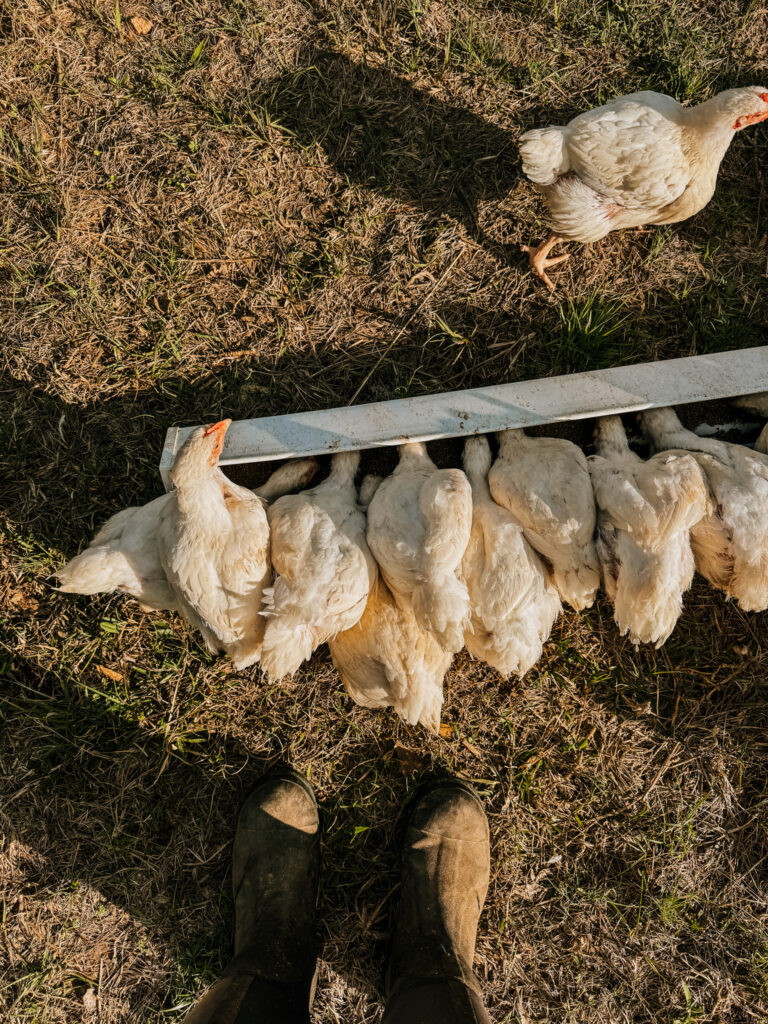
A Note About Culling Chickens
There’s another important thing to consider when feeding chickens on a budget: culling older chickens who are no longer laying eggs. I know it might sound harsh, but it’s actually a savvy way to save on feed costs.
As chickens age, their egg production naturally slows down. And while they may still be beloved members of your flock, keeping non-productive hens around can be a drain on your feed budget. By culling older chickens and replacing them with younger, more productive hens, you can maximize your egg production and minimize your feed expenses.
Of course, it’s important to do so humanely and responsibly. And remember, older chickens can still make for tasty and nutritious meat, so nothing goes to waste.
Feeding Chickens on a Budget FAQS
What’s the cheapest type of chicken feed?
Scratch grains are usually the cheapest option, but they might not have all the nutrients your chickens need. Laying pellets or crumbles are more balanced, but they can be pricier. It’s all about finding the right balance for your flock and your budget.
Can I feed my chickens leftovers from the kitchen?
Yes! Chickens are pretty versatile eaters. They’ll chow down on fruit and veggie scraps, bread, pasta. Just steer clear of anything toxic or spoiled, and your chickens will be happy!
How much feed does a chicken need per day?
On average, a chicken will munch through about 1/4 to 1/3 pounds of feed each day. Of course, that can vary depending on factors like breed, age, and how much they’re strutting around the coop.
Is it worth it to grow my own feed for chickens?
If you’ve got the space and resources, growing your own feed can be a great way to save money and give your chickens fresh, nutritious grub. Plus, it’s a fun project to tackle in your backyard.
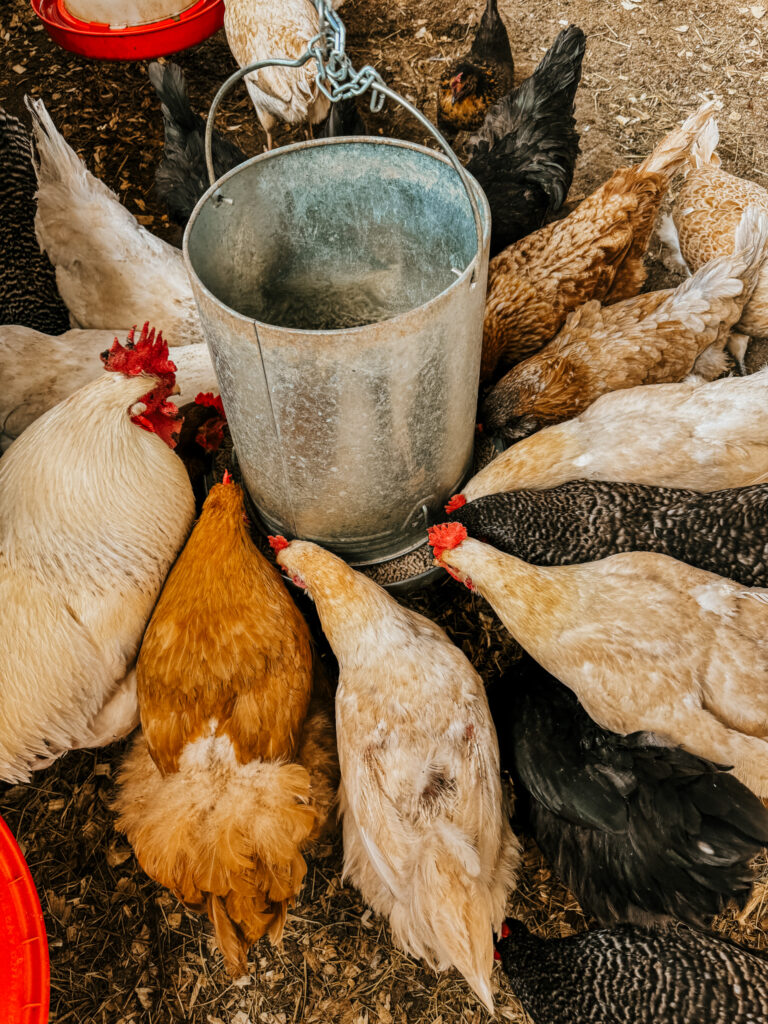
Final Thoughts
Whether you’re letting your hens free-range, growing them a garden, or fermenting their feed, there are plenty of ways to keep your feathered friends happy and your wallet full.
If you enjoyed this chicken article, please share it! Thanks for visiting my farm.

Shop This Post – Shop my favorite chicken coop products here!
Leave a Reply